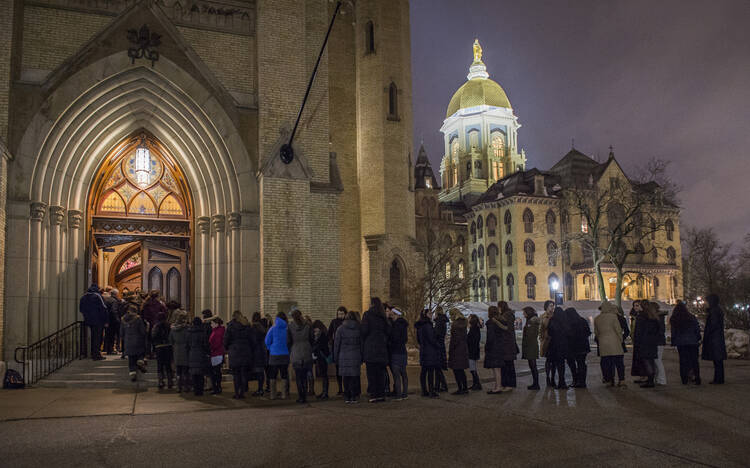LAS VEGAS (CNS) — The University of Notre Dame Sept. 21 released a groundbreaking report that looked at sexual harassment in U.S. Catholic seminaries, revealing that just 6 percent of seminarians reported experiencing some form of sexual harassment or misconduct, while 90 percent reported none.
Another 4 percent said they might have experienced misconduct but were not sure. Of the 10 percent who reported they had experienced sexual harassment or indicated they might have, 80 percent percent identified a fellow seminary student or religious in formation as the alleged perpetrator.
Among the respondents overall, 84 percent said they felt the administration and faculty take seriously reports of harassment. Of those who reported an incident, about a third said they were not sure how seriously their report was taken or whether it was acted upon.
The research, from Notre Dame's McGrath Institute for Church Life, in collaboration with the Washington-based Center for Applied Research in the Apostolate, came from data obtained from 149 seminaries or houses of formations in the United States. The study is titled "Sexual Harassment and Catholic Seminary Culture."
John Cavadini, Notre Dame professor of theology, who presented the results at the Religion News Association conference in Las Vegas, said the survey was a response to rumors about what was happening in seminary culture after allegations surfaced concerning former U.S. Cardinal Theodore E. McCarrick.
"The vision for the survey came in the wake of the clerical sex abuse scandal and abuse allegations against the now-laicized Theodore McCarrick, who was accused of grooming victims during their seminary years," Cavadini said.
With data, constructive change could take place and affect policies that may be needed to make the country's Catholic seminaries safer, he said.
Some of the concerns seem to center on the question of whether reports of sexual harassment were taken seriously and acted on by the responsible authorities. Of those who reported an incident, about four in 10 (42 percent) believe that their reports of sexual harassment, abuse or misconduct "to the responsible authorities" were taken seriously and acted upon "completely" (24 percent) or "for the most part" (18 percent).
Twelve percent said that their reports were taken seriously "somewhat, but not adequately," and 15 percent said they believed their reports were "not taken seriously or properly acted upon." Those who said they "didn't know" how seriously their reporting of an incident was taken or whether it was acted upon accounted for 31 percent; and 21 percent said reports were "not taken seriously or properly acted upon."
"We hope to hold people to a higher standard," Cavadini said.
The survey was emailed to 2,375 seminarians from 149 seminaries and houses of formation around the country with a 65 percent response rate. Cavadini said researchers tried to compare some of the data, but there weren't studies focused on the seminary culture to make a comparison.
Jesuit Father Thomas Gaunt, executive director of CARA, who was present for the release of the results, said he believed the research marked the first time such a study has been undertaken. Some of the data can help create or institute policies to ensure that seminarians who report abuse against them will be taken seriously by those in charge, he noted.
"It's not just our opinion. We have data to show so we'll be able to say that it is not our imagination," Cavadini said. "We want to affect the seminary culture. We want to create a culture where that ambiguity goes down."
In a Sept. 21 statement from Notre Dame introducing the research, Cavadini said that in approaching the report, researchers wanted to give seminarians a voice without fearing reprisal.
"As a service to the current and future church, we wanted to try to get some objective data on how prevalent (or not) sexual abuse and harassment might be at seminaries," he said.










Just wondering if the study covered the emotional and spiritual abuse of homosexual seminarians by the heterosexual ones?
what year were the seminarians in--freshmen or seniors? Length of time in the seminary would be a big factor in honest responding.
Bill Dempsey
Why did you omit the fact that radically limits the significance of the findings, i.e., that more than half of the country’s seminaries (77 out of 149) did not participated? Indeed, 55 “never acknowledged receipt of the invitation despite multiple attempts to contact them by mail, by phone, or at multiple email addresses.” It is reasonable to infer that those in governance of many of these had something they didn’t want disclosed and that the survey findings would have been a good deal more troublesome if it had been. Moreover, with 80% of the reported abuses both nationally and in the Pennsylvania grand jury study homosexual, one question not posed in this study is how many seminaries still admit homosexuals with “deep-seated homosexual tendencies” despite the direction of three Popes that they not.. The limited results nevertheless suggest, though they do not establish, that some seminaries are not complying. Again, non-compliance is likely to found to a greater extent in the seminaries that refused to participate. This is a job for the USCCB, but there is no good reason to suppose it will be undertaken..